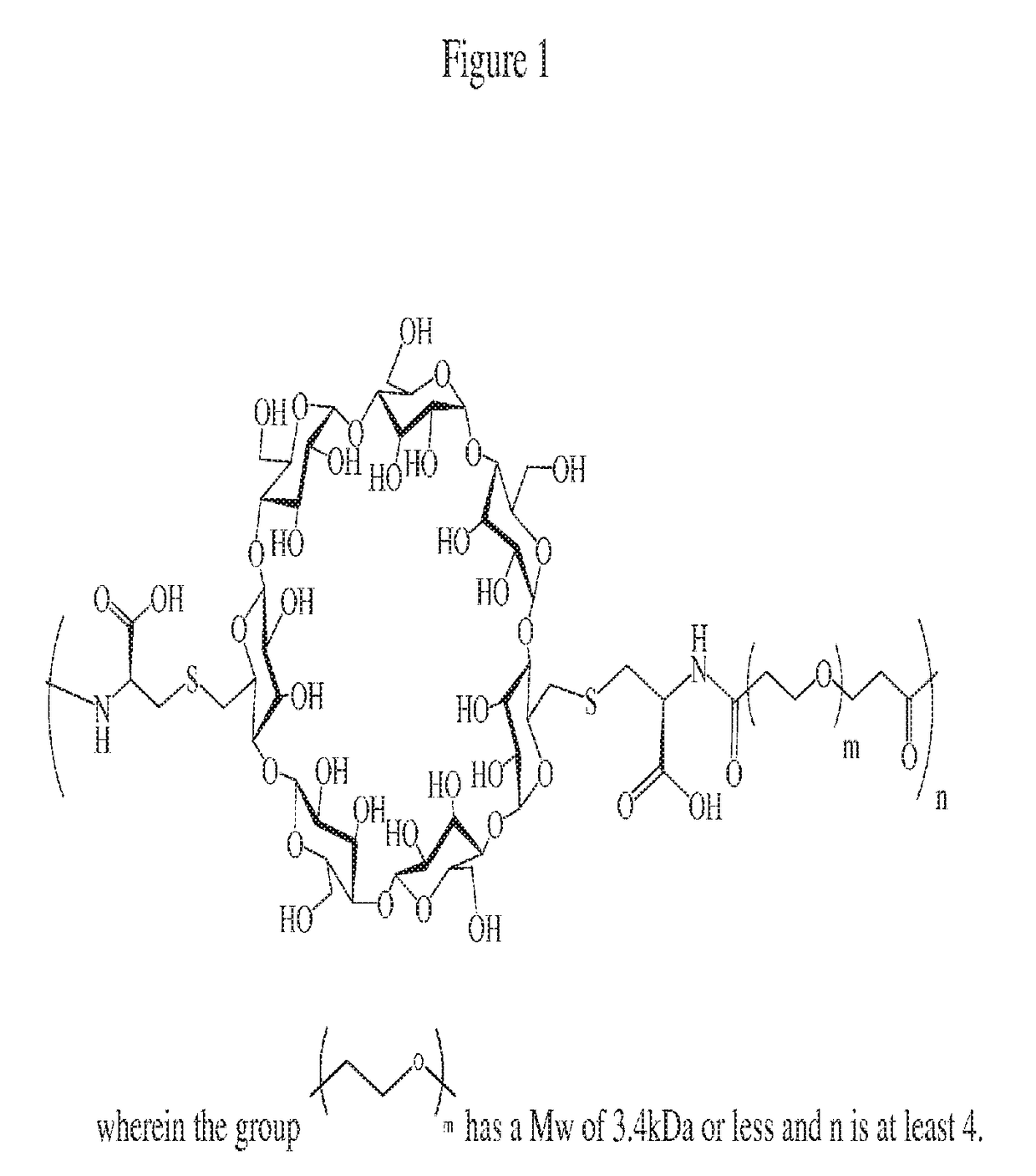Cyclodextrin-based polymers for therapeutic delivery
a technology of cyclodextrin and polymer, which is applied in the direction of antineoplastic agents, organic active ingredients, drug compositions, etc., can solve the problems of toxic side effects, poor pharmacological profiles, and difficult delivery of small molecule therapeutic agents such as taxan
- Summary
- Abstract
- Description
- Claims
- Application Information
AI Technical Summary
Benefits of technology
Problems solved by technology
Method used
Image
Examples
example 1
2′-(6-(carbobenzyloxyamino) caproyl) docetaxel
[1660]A 500-mL round-bottom flask equipped with a magnetic stirrer was charged with 6-(carbobenzyloxyamino) caproic acid (4.13 g, 15.5 mmol), docetaxel (12.0 g, 14.8 mmol), and dichloromethane (240 mL). The mixture was stirred for 5 min to produce a clear solution, to which 1-ethyl-3-(3-dimethylaminopropyl)carbodiimide hydrochloride (EDC.HCl) (3.40 g, 17.6 mmol) and 4 dimethylaminopyridine (DMAP) (2.15 g, 17.6 mmol) were added. The mixture was stirred at ambient temperature for 3 h at which time, IPC analysis showed a 57% conversion along with 34% residual docetaxel. An additional 0.2 equivalents of EDC.HCl and DMAP were added and the reaction was stirred for 3 h, at which time IPC analysis showed 63% conversion. An additional 0.1 equivalents of 6-(carbobenzyloxyamino) caproic acid along with 0.2 equivalents of EDC.HCl and DMAP were added. The reaction was stirred for 12 h and IPC analysis indicated 74% conversion and 12% residual doceta...
example 3
of CDP-hexanoate-docetaxel
[1662]CDP (4.9 g, 1.0 mmol) was dissolved in dry N,N-dimethylformamide (DMF, 49 mL). 2′-(6-aminohexanoyl) docetaxel MeSO3H (2.0 g, 2.2 mmol), N,N-Diisopropylethylamine (290 mg, 2.2 mmol), N-(3-Dimethylaminopropyl)-N′-ethylcarbodiimide hydrochloride (580 mg, 3.0 mmol), and N-Hydroxysuccinimide (250 mg, 2.2 mmol) were added to the polymer solution and stirred for 4 h. The polymer was precipitated with acetone (500 mL). It was then rinsed with acetone (100 mL). The product contained CD-hexanoate-docetaxel and could contain free CDP and traces of free docetaxel.
[1663]The CDP hexanoate-docetaxel was dissolved in water (490 mL). The solution was dialyzed using a tangential flow filtration system (30 kDa MW cutoff, membrane area=50 cm2). It was then concentrated to 20 mg of CDP-hexanoate-docetaxel / mL. It was then formulated with mannitol and filtered through 0.2 μm filters (Nalgene) and lyophilized to yield white solid.
example 4
on of CDP-hexanoate-docetaxel Nanoparticles
[1664]CDP-hexanoate-docetaxel (100 mg) as prepared in example 3 above was dissolved in water (10 mL). Particle solution properties were characterized by dynamic light scattering (DLS) spectrometer.
[1665]Particle properties, evaluated by using the resulting plurality of particles made in the method above:[1666]Zavg=47.0 nm[1667]Particle PDI=0.587[1668]Dv50=11.2 nm[1669]Dv90=18.2 nm
PUM
| Property | Measurement | Unit |
|---|---|---|
| chemotherapeutic refractory | aaaaa | aaaaa |
| CNS disorder | aaaaa | aaaaa |
| metabolic disorder | aaaaa | aaaaa |
Abstract
Description
Claims
Application Information
 Login to View More
Login to View More - R&D
- Intellectual Property
- Life Sciences
- Materials
- Tech Scout
- Unparalleled Data Quality
- Higher Quality Content
- 60% Fewer Hallucinations
Browse by: Latest US Patents, China's latest patents, Technical Efficacy Thesaurus, Application Domain, Technology Topic, Popular Technical Reports.
© 2025 PatSnap. All rights reserved.Legal|Privacy policy|Modern Slavery Act Transparency Statement|Sitemap|About US| Contact US: help@patsnap.com



